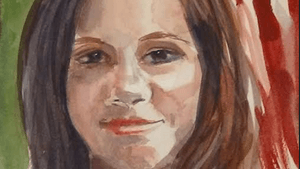Stay in the Loop
BSR publishes on a weekly schedule, with an email newsletter every Wednesday and Thursday morning. There’s no paywall, and subscribing is always free.
Getting back to basics
A lapsed painter picks up the brush

I recently signed up for a six-week “Introduction to Watercolor” class at Abington Art Center. I majored in painting in college, but hadn’t touched a brush in over 40 years, other than to slap Sherwin Williams Eggshell White on a bedroom wall. Why had I stopped? Because making a living took priority over making art.
I was nervous. Suppose I didn’t have “it” anymore? Plus, I had no experience with watercolor, which I knew to be trickier than oils or acrylics. As the first day of class approached, I talked to myself like a life coach, “No one is judging you. Whatever you do is okay.”
Meeting old friends
I distracted myself by buying art supplies and reintroducing myself to the old friends of my youth: alizarin crimson, yellow ochre, cobalt blue, burnt sienna, cadmium orange, burnt umber. I had almost forgotten the delirious happiness of new paints, brushes, and paper.
The supplies alone felt like a passkey to being a 19-year-old University of the Arts student again. However, walking into the first class banished any thoughts of the Fountain of Youth. My classmates were women my age, retirees and grandmothers who regarded art as a good fit for their other hobbies: Pilates, yoga, knitting, and Bridge. I immediately relaxed. No one was there to prove anything. The instructor, an exuberant middle-aged woman, started off slowly, demonstrating the basics.
I felt as giddy as a child at summer camp. I was playing! The first class was mostly lecture and demonstration, but for the second class, the instructor set up a simple still life: A teapot and an artificial lemon and apple. Not exactly Cezanne material. Within seconds, I was in the “zone,” so immersed in the process I had no idea what was going on around me, madly mixing colors, laying down washes, giving volume to two-dimensional forms. The instructor peered over my shoulder and asked suspiciously, “What’s your background?”
“Um, I was an art major in college but haven’t done anything since.”
Finding the highlights
The following week, I finished the still life and I was thrilled. And baffled. My first painting in decades was better than anything I had ever done in art school. How was that possible?
God knows, my eyesight isn’t better than it was in my teens. I can’t make a cell phone call without magnifying glasses. Could my manual dexterity have improved? Doubtful. Stuff falls out of my hands of its own accord lately. That leaves only one possibility. I am more mature. I have more confidence. I make better decisions, whether choosing what to eat for breakfast (cold pepperoni pizza doesn’t cut it anymore), or what colors to mix to get just the right shade of violet.
In spite of my success, something wasn’t right about my still life painting. Watercolor is supposed to be transparent and my painting was opaque. That’s when I realized what I had done wrong. The secret of watercolors is to work from light to dark, always letting the paper itself be the source of highlights. I had done the opposite, which is standard in oils, but death to watercolor.
As if reading my mind, the teacher gave us an exercise that forced me to adapt to watercolor technique. She told us to do croquis, quick watercolor sketches of a model’s constantly changing poses, each lasting no more than five minutes. We were instructed not do any preliminary drawing. Just work directly with paint to capture the spirit of the pose, leaving no time for details. Wherever I wanted to create highlights, I left the paper white.
When it was time for a critique, the instructor walked around the room and so did the students, looking at everyone’s work.
“That’s better than I could do,” said the instructor, quickly moving on.
Other students clustered around me, asking how I got my flesh tones, mixed colors, and what brand of paints I used. How could I explain that I was as shocked as they were? Many students in the class will be taking this course again in the fall. I will not. Instead, I am enrolling at the Woodmere Art Museum, where I am told the watercolor instructor is more “demanding” and “rigorous.”
In the meantime, I’m reading up on watercolor technique, experimenting with methods and materials. Now that I have reclaimed that lost part of myself, I don’t want to merely rejoice in its existence. I want to see where it will take me.
Sign up for our newsletter
All of the week's new articles, all in one place. Sign up for the free weekly BSR newsletters, and don't miss a conversation.

 Stacia Friedman
Stacia Friedman